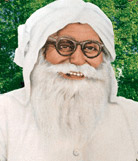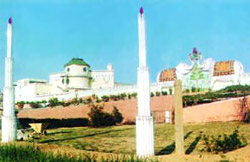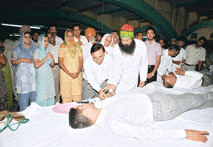 Dera Sacha Sauda set up by Shah Mastana from Baluchistan in 1948 is a center for religious learning based upon liberal theology. It is a non-profit spiritual organization based in Sirsa in Haryana, which has ten million followers. Shah Mastana, the founder of Dera Sacha Sauda was succeeded by Shah Satnam Singh in the year 1992 who was followed by Gurmeet Ram Raheem Singh and then Hazoor Maharaj .
Dera Sacha Sauda set up by Shah Mastana from Baluchistan in 1948 is a center for religious learning based upon liberal theology. It is a non-profit spiritual organization based in Sirsa in Haryana, which has ten million followers. Shah Mastana, the founder of Dera Sacha Sauda was succeeded by Shah Satnam Singh in the year 1992 who was followed by Gurmeet Ram Raheem Singh and then Hazoor Maharaj .
Being a non-profit organization the organization does not accept any gifts, alms or donations .The inhabitants of the ashram work in the agricultural fields and the income from the produce is utilized for social welfare activities and meets the expenses of the organization.
 The name Dera Sacha Sauda is related with a true-life incident of Guru Nanak .It is believed that when Guru Nanak was twelve years old his father gave him twenty rupees to do business. Guru Nanak bought food with all the money and gave it to saints and poor. He told his father that he had done a "True business." Sacha Sauda is believed to be the place where Guru Nanak fed the poor.
The name Dera Sacha Sauda is related with a true-life incident of Guru Nanak .It is believed that when Guru Nanak was twelve years old his father gave him twenty rupees to do business. Guru Nanak bought food with all the money and gave it to saints and poor. He told his father that he had done a "True business." Sacha Sauda is believed to be the place where Guru Nanak fed the poor.
The principles of this organization are secularism ,equality ,rejection of materialistic wealth ,leading a true life ,strict individual discipline ,hardwork and meditation as enumerated by Gurmeet Ram Raheem Singh in order to attain Moksha.
 The principal source of income of the organization is agriculture . The organization runs a hospital in Ganganagar, Rajasthan, which is the birth place of Saint Gurmeet Ram Raheem Singh Ji, along with a hostel for girls, a boys` school and a degree college in Haryana. Dera Sacha Sauda has been twice recognized by Guinness World Records for massive blood donation camps:A camp conducted by Gurmeet Ram Raheem Singh in Sirsa, Haryana on 7th December 2003, in which 15,432 donors participated in merely 12 hours. A camp was organized in Bapu Ji village, Sriganganagar, India on 10th October 2004 in which 17,921 donors participated.
The principal source of income of the organization is agriculture . The organization runs a hospital in Ganganagar, Rajasthan, which is the birth place of Saint Gurmeet Ram Raheem Singh Ji, along with a hostel for girls, a boys` school and a degree college in Haryana. Dera Sacha Sauda has been twice recognized by Guinness World Records for massive blood donation camps:A camp conducted by Gurmeet Ram Raheem Singh in Sirsa, Haryana on 7th December 2003, in which 15,432 donors participated in merely 12 hours. A camp was organized in Bapu Ji village, Sriganganagar, India on 10th October 2004 in which 17,921 donors participated.
The Parampita Shah Satnamji Educational and Welfare Society, which is affiliated to Dera Sacha Sauda, built the Shah Satnamji Cricket Stadium in Sirsa, Haryana. Using a workforce of 10,000, the stadium was said to have been built in 45 days and have a capacity of 30,000. It is spread over 100 acres, which would make the second largest in Asia.
Dera Sacha Sauda also runs a Drug Rehabilitation Centre in Sirsa, where many people have been treated. Gurmeet Ram Raheem Singh started a Drug Prevention Campaign against the use of intoxicants and inspires people to give up their drug addiction in every spiritual congregation. People willing to give up their addiction stay in Dera Sacha Sauda for seven days and medical treatment is available for them free of cost. The institution sees chemical dependency (Drug Addiction) as a behavioural disorder and encourages the addicts to bring about a positive change in their personality.




















